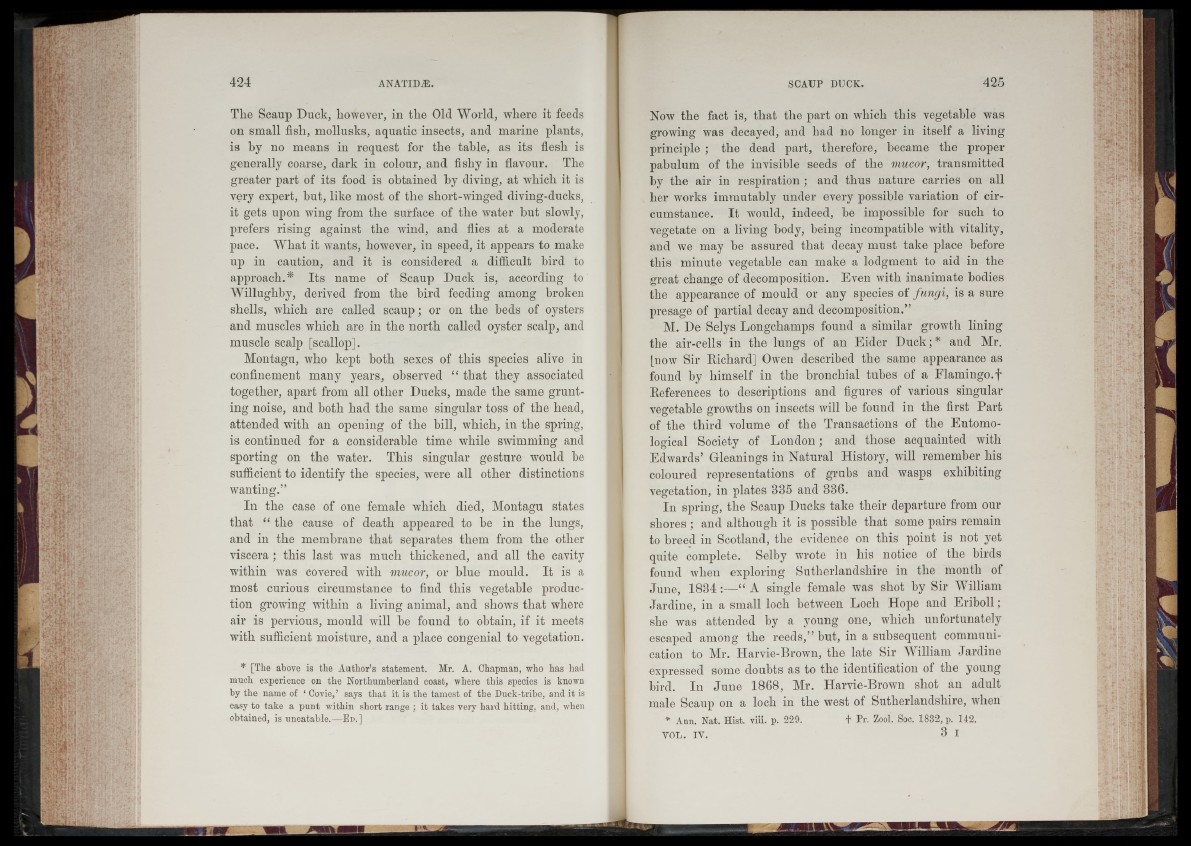
Tlie Scaup Duck, however, in the Old World, where it feeds
on small fish, mollusks, aquatic insects, and marine plants,
is by no means in request for the table, as its flesh is
generally coarse, dark in colour, and fishy in flavour. The
greater part of its food is obtained by diving, at which it is
very expert, hut, like most of the short-winged diving-ducks,
it gets upon wing from the surface of the water but slowly,
prefers rising against the wind, and flies at a moderate
pace. What it wants, however, in speed, it appears to make
up in caution, and it is considered a difficult bird to
approach.* Its name of Scaup Duck is, according to
Willugliby, derived from the bird feeding among broken
shells, which are called scaup; or on the beds of oysters
and muscles which are in the north called oyster scalp, and
muscle scalp [scallop].
Montagu, who kept both sexes of this species alive in
confinement many years, observed “ that they associated
together, apart from all other Ducks, made the same grunting
noise, and both had the same singular toss of the head,
attended with an opening of the bill, which, in the spring,
is continued for a considerable time while swimming and
sporting on the water. This singular gesture would be
sufficient to identify the species, were all other distinctions
wanting.”
In the case of one female which died, Montagu states
that “ the cause of death appeared to be in the lungs,
and in the membrane that separates them from the other
viscera ; this last was much thickened, and all the cavity
within was covered with mucor, or blue mould. It is a
most curious circumstance to find this vegetable production
growing within a living animal, and shows that where
air is pervious, mould will be found to obtain, if it meets
with sufficient moisture, and a place congenial to vegetation.
* [The above is the Author’s statement. Mr. A. Chapman, who has had
much experience on the Northumberland coast, where this species is known
by the name of ‘ Covie,’ says that it is the tamest of the Duck-tribe, and it is
easy to take a punt within short range ; it takes very hard hitting, and, when
obtained, is uneatable.—Ed.]
Now the fact is, that the part on which this vegetable was
growing was decayed, and had no longer in itself a living
principle ; the dead part, therefore, became the proper
pabulum of the invisible seeds of the mucor, transmitted
by the air in respiration ; and thus nature carries on all
her works immutably under every possible variation of circumstance.
It would, indeed, be impossible for such to
vegetate on a living body, being incompatible with vitality,
and we may be assured that decay must take place before
this minute vegetable can make a lodgment to aid in the
great change of decomposition. Even with inanimate bodies
the appearance of mould or any species of fungi, is a sure
presage of partial decay and decomposition.”
M. De Selys Longcliamps found a similar growth lining
the air-cells in the lungs of an Eider Duck;* and Mr.
[now Sir Richard] Owen described the same appearance as
found by himself in the bronchial tubes of a Flamingo.f
References to descriptions and figures of various singular
vegetable growths on insects will be found in the first Part
of the third volume of the Transactions of the Entomological
Society of London; and those acquainted with
Edwards’ Gleanings in Natural History, will remember his
coloured representations of grubs and wasps exhibiting
vegetation, in plates 335 and 336.
In spring, the Scaup Ducks take their departure from our
shores ; and although it is possible that some pairs remain
to breed in Scotland, the evidence on this point is not yet
quite complete. Selby wrote in his notice of the birds
found when exploring Sutherlandshire in the month of
June, 1834:—“ A single female was shot by Sir William
Jardine, in a small loch between Loch Hope and Eriboll ;
she was attended by a young one, which unfortunately
escaped among the reeds,” but, in a subsequent communication
to Mr. Harvie-Brown, the late Sir William Jardine
expressed some doubts as to the identification of the young
bird. In June 1868, Mr. Harvie-Brown shot an adult
male Scaup on a loch in the west of Sutherlandshire, when
* Ann. Nat. Hist. viii. p. 229. t Pr. Zool. Soc. 1832, p. 142.